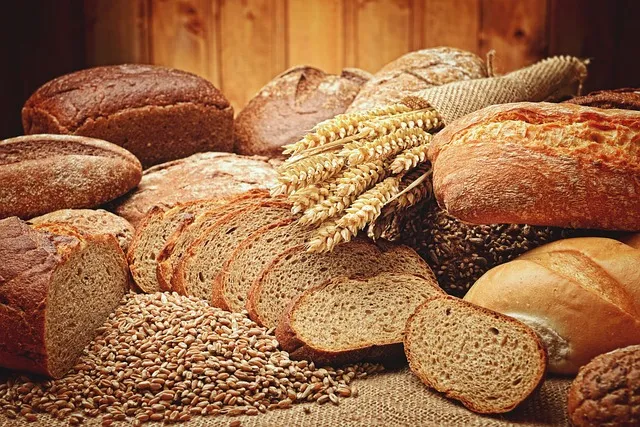Is Bread Healthy?

The effect of bread on fitness depends on a number of factors, including the type of bread, the amount consumed, and an individual’s overall diet and fitness goals.
Bread can be a good source of carbohydrates, which are important for providing energy for physical activity. However, some types of bread can also be high in refined carbohydrates and added sugars, which can contribute to weight gain and negative health outcomes. Being age 40 and over we need to watch our refined carb and sugar intakes.
The most common types of bread are:
- White Bread
- Whole Wheat Bread
- Whole Grain Bread
- Low Carb Bread
White Bread is made from refined wheat flour, which means that the bran and germ have been removed during processing. This results in a finer texture and longer shelf life, but it also means that white bread has lower levels of fiber, vitamins, and minerals than whole wheat bread. White bread is also more likely to cause spikes in blood sugar levels, which can lead to energy crashes and hunger pangs.
Whole Wheat Bread is made from whole wheat flour, which includes the bran and germ. This means that whole wheat bread is higher in fiber, vitamins, and minerals, and it has a lower glycemic index than white bread, which means that it can help regulate blood sugar levels and keep you feeling fuller for longer. Whole wheat bread is considered to be a healthier choice than white bread, as it provides more nutrients and is better for regulating blood sugar levels. However, it’s worth noting that not all whole wheat bread is created equal – some varieties may contain added sugar, preservatives, or other additives that can detract from their health benefits. It is a good source of fiber and nutrients, but it may not contain other grains besides wheat.
Whole Grain Bread, on the other hand, can be made from a variety of whole grains, including wheat, rye, oats, and barley. In addition to containing the entire grain, including the bran, germ, and endosperm, whole grain bread can also contain other grains and seeds, such as millet, quinoa, or flax seeds. As a result, whole grain bread may offer a wider range of nutrients compared to whole wheat bread.
Whole grain breads, can be a good source of fiber, which can help regulate blood sugar and promote feelings of fullness. This can help support weight management and overall health. They are generally higher in carbohydrates compared to some other types of bread. However, it’s important to note that not all carbohydrates are created equal. Whole grain breads contain complex carbohydrates, which are digested more slowly than simple carbohydrates, such as those found in sugary foods and refined grains.
When eaten in moderation as part of a balanced diet, whole grain bread can be a healthy choice. It’s also worth noting that the glycemic index of whole grain bread can vary depending on the specific type and ingredients used.
Low Carb Bread is a type of bread that is made with ingredients that are lower in carbohydrates than traditional bread. Generally, low carb bread is made with ingredients like almond flour, coconut flour, flaxseed, and other low-carbohydrate alternatives to wheat flour.
The exact carbohydrate content of low carb bread can vary depending on the recipe and the ingredients used, but typically, it contains significantly fewer carbs than traditional bread. This makes it a popular choice for people who are following low-carb diets, such as the ketogenic diet, or those who are looking to reduce their overall carbohydrate intake.
Some types of low carb bread may also be higher in protein and fiber than traditional bread, which can help to keep you feeling fuller for longer and may offer additional health benefits.
Low carb breads offer several potential benefits, including:
- Reduced Carbohydrate Intake: By replacing traditional bread with low-carb alternatives, you can reduce your carbohydrate intake, which can help you manage your blood sugar levels and aid in weight loss.
- Improved Blood Sugar Control: Eating low carb breads can help control blood sugar levels, making them a good choice for people with diabetes or insulin resistance.
- Increased Satiety: Low carb breads may be more filling than traditional bread due to their higher protein and fat content, which can help you feel fuller for longer periods of time.
- Lowered Inflammation: Low carb breads typically contain fewer ingredients, which can reduce the likelihood of consuming inflammatory ingredients that can cause discomfort.
- Better Digestive Health: Some low carb breads contain higher fiber content, which can improve digestive health, and maintain bowel movements.
- Lowered Risk of Heart Disease: Some low carb breads are made with healthy fats, which can help reduce your risk of heart disease by lowering cholesterol levels.
It is important to note that not all low carb breads are created equal, and some may still contain high amounts of calories, unhealthy fats, and added sugars. Therefore, it is essential to read the ingredient list and nutrition label before selecting a low carb bread to ensure it is a healthy and nutritious option.
Shop Great Low Carb Bread Today!Disclaimer: Always consult your doctor before trying anything mentioned in this article. All information in this email is intended for educational use only and is not a substitute for professional medical advice, diagnosis, or treatment. Fit Dads Over 40 is not responsible for the accuracy, completeness, suitability, or validity of any information in this article. Some of the links on this site are affiliate links. This means that, at zero cost to you, we will earn an affiliate commission if you click through the link and finalize a purchase.


